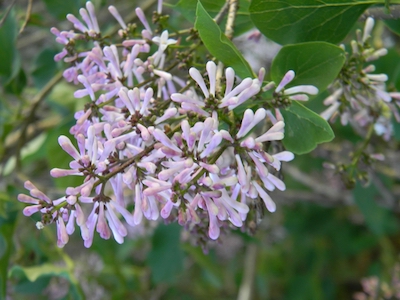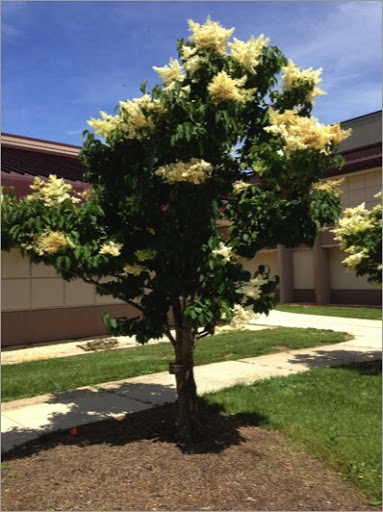Lovely Lilacs Create a Feast for Your Senses
By Carolyn R. Casey, Fairfax Master Gardener
 Would you enjoy strolling through your yard or garden on a lovely spring day admiring beautiful clusters of pink to purple flowers and enjoying a sweet fragrance? Then you may want to consider adding lovely and fragrant lilacs to you garden. Lilacs bloom for 10 to 14 days in the spring with very fragrant and beautiful pink to purple flowers. They provide shelter for birds plus food for pollinators. Lilacs are native to eastern Europe as well as Asia and grow in Zones 3 to 7. Did you know that the Lilac’s genus name Syringa comes from the Greek word meaning pipe or tube and has to do with the lilac’s stem that can be hallowed out?
Would you enjoy strolling through your yard or garden on a lovely spring day admiring beautiful clusters of pink to purple flowers and enjoying a sweet fragrance? Then you may want to consider adding lovely and fragrant lilacs to you garden. Lilacs bloom for 10 to 14 days in the spring with very fragrant and beautiful pink to purple flowers. They provide shelter for birds plus food for pollinators. Lilacs are native to eastern Europe as well as Asia and grow in Zones 3 to 7. Did you know that the Lilac’s genus name Syringa comes from the Greek word meaning pipe or tube and has to do with the lilac’s stem that can be hallowed out?
Lilacs must grow and mature before they are capable of flowering. For instance, the common or French hybrid lilac (Syringa vulgaris) often does not bloom for five or more years after planting, while the dwarf Korean lilac (Syringa meyeri), ‘Miss Kim’ lilac (Syringa patula ‘Miss Kim’) and Preston lilacs (Syringa x prestoniae) often flower within one or two years after planting.
Lilacs prefer well-drained soils and need at least six hours of full sun light. When planted in partial shade they will not bloom well. Applying a 2- to 3-inch (5 – 7cm)layer of mulch around each shrub helps to conserve soil moisture during dry weather and control weeds. Lilacs can be lightly fertilized in early spring, but heavy fertilization may promote too much vegetative growth and discourage flowering.
Pruning can also affect flowering since lilacs bloom on the previous year’s growth. The best time to prune them is immediately after they bloom in spring. Pruning lilacs in late summer, fall or winter may remove many of next year’s flower buds since they set next year’s buds right after they finish blooming. Deadheading improves the appearance of lilacs and prevents seed pods from forming. As a result, lilacs that are deadheaded after flowering often flower more heavily the following year than those that are not deadheaded. When deadheading lilacs, make the pruning cut at the base of the flower cluster and just above the uppermost leaves.
There are three groups of lilacs that are usually sold at garden centers. They are large upright shrubs, densely branched shrubs and tree form lilacs.

Syringa vulgaris
Large Upright Shrub Lilacs
The common lilac also known as Syringa vulgaris is a very fragrant large upright shrub that grows 4 to 8 feet tall. It blooms in April or May with either single or double blooms in a variety of colors from white, violet, blue, lilac, pink, magenta and purple flowers. It has been used in gardens since the 16th century and has about 2,000 cultivars. Most are taller than 8 feet tall, and some can be 4 to 8 feet tall. They grow well in Zones 3 to 7, and when established they will tolerate drought and poor soils. They also need full sun.
Common lilacs need rejuvenation pruning, and there are two ways to prune them. Each year prune out about one-third of the largest stems or cut the entire plant to about 1 1/2 feet above ground level. When choosing the second option, the next year your lilac may not flower or have only a few flowers depending on when it was pruned. The common lilac also forms suckers that need to be kept pruned.
These lilacs are susceptible to powdery mildew that makes their foliage seems to have a white powder on it. It is due to cool nights and warm days, and lilacs grown in dense shade are more prone to it. Powdery mildew does not seriously harm lilacs; therefore, it is not necessary to spray with a fungicide. As long as the lilac receives a minimum of six hours of direct sunlight a day, then powdery mildew will not be a problem.

Syringa meyeri
Densely Branched Shrub Lilacs
The Syringa meyeri also known as Meyer lilac, and Syringa pubescens subsp. Patula, also known as Manchurian lilac, are dense shrubs that grow 8 feet tall and 12 feet wide. They are easy care since they do not need rejuvenation pruning like the common lilacs, and they do not form suckers or get powdery mildew. The Meyer lilac blooms in April with fragrant violet purple flowers that fade to pink and grows in Zones 3 to 7. ‘Palibin’ is a popular cultivar. The Manchurian lilac blooms with fragrant pink flowers and grows well in Zones 4 to 7. ‘Miss Kim’ is a popular cultivar. Manchurian lilacs are somewhat tolerant of drought and poor soils while the Meyer lilac tolerates drought and poor soils. Both need full sun.

Syringa reticulata
Tree Form Lilacs
Syringa reticulata, the Japanese tree lilac, and S. reticulata subsp. pekinensis also known as the Pekin Lilac, are either large shrubs or small trees and can grow up to 25 feet tall. They bloom in June with cream-white fragrant flowers. The Japanese tree lilac resists mildew and grows well in Zones 3 to 7. ‘Ivory Silk’ is a popular cultivar. The Pekin lilac grows well in Zones 4 to 7. Some cultivars like ‘China Snow’ and ‘Summer Charm’ have exfoliating brown bark while ‘Beijing Gold’ has yellowish flowers. ‘China Snow’ is the most interesting due to its amber-brown bark that exfoliates into long curly swirls. Both of these lilacs tolerate drought and poor soils.
Conditions That May Affect Lilacs
Bacterial leaf spot and bacterial leaf blight are diseases that can affect lilacs and often start out as small dark brown or black spots that have a yellow halo around each spot. Sometimes the leaf spot will dry up and fall out. Depending on the weather the leaf spots may grow together and create large black spots on the leaves, or the leaves may turn completely black. The shoots, buds and flowers can also become black. It is caused by Pseudomonas spp. or Xanthomonas spp. and can live on plant surfaces in low numbers without causing symptoms. They can travel great distances on moist currents or short distances on splashing rain and irrigation. Most fungicide sprays do not protect a tree or shrub from bacterial pathogens, and only sprays with copper or streptomycin are effective in preventing bacterial diseases. Fungicides are needed if the plant has lost its leaves for several years in a row, and they need to be applied before the symptoms appear. Also rake up and destroy all leaves in the fall.
Pseudocercospora leaf spot can be a problem for lilacs. The spores of Pseudocercospora can live for several years on plant debris (leaves, stems, dead flowers or bark). Syringa vulgaris, the common lilac, is the most affected species, and S. reticulata, the tree lilac, is also affected. It can affect mature plants that have never had a problem before. The leaves turn yellow, then brown and then fall off. There is also branch dieback that can be random. It is recommended that you clean up fallen leaves and destroy them to help reduce the likelihood of your lilac being re-infected next year. Prune the lilac so more light travels throughout the plant and new growth is encouraged. Also, consistent watering will help support the stressed plant.
Verticillium wilt affects lilacs and is caused by two fungi, Verticillium dahlia and Verticillium albo-atrum. There is no cure for fungal infection. The branches turn brown and suddenly die since the fungi block the vascular system of the branch and cut off the water and nutrients. To extend the life of your lilac, increase watering and fertilization. The best way to prevent Verticillium wilt is to purchase cultivars that are resistant and to practice good sanitation.
Another problem for lilacs is the lilac borer or ash borer. They tunnel into the lilac branches, showing damage including sawdust, sap and frass. Some lilacs may be able to tolerate the damage caused by borers while others will experience branch dieback. Some lilacs will die. We may not notice borer damage until it is too late.
Diagnosing Lilac Issues
When trying to diagnose a problem with your lilac, it could be due to either abiotic or biotic conditions or both. If it is an abiotic problem, it could be due to herbicide damage, storm damage, drought, flooding or a mechanical problem. The treatment for these problems are renewal pruning, watering, mulching and fertilizing. Biotic damage is due to insects and disease pathogens like fungi, bacteria and virus. The treatment for biotic problems is to look for signs of insect damage like sawdust, sap, frass and entrance and exit holes. Prune out affected branches to prevent further damage.
So you will find that lilacs add beautiful flowers and a sweet fragrance to your landscape. Consider adding these wonderful plants to your garden. Happy gardening!
Resources
• Yard and Garden: Lilacs, Richard Jauron, Willy Klein, Iowa State University Extension and Outreach
• Growing lilacs for Minnesota landscapes, Julie Weisenhorn, University of Minnesota Extension
• Leaf spot disease of trees and shrubs, Michelle Grabowski, University of Minnesota Extension
• What should I do about the powdery mildew on my lilacs?, Emma Erler, University of New Hampshire
Cooperative Extension
• Lilacs, Syringa spp., Alex X. Niemiera, Virginia Tech